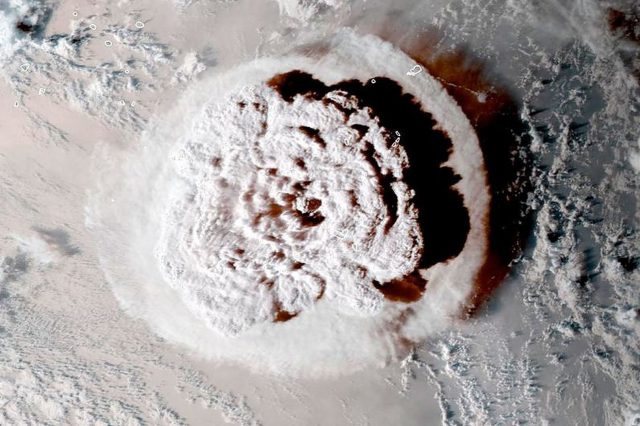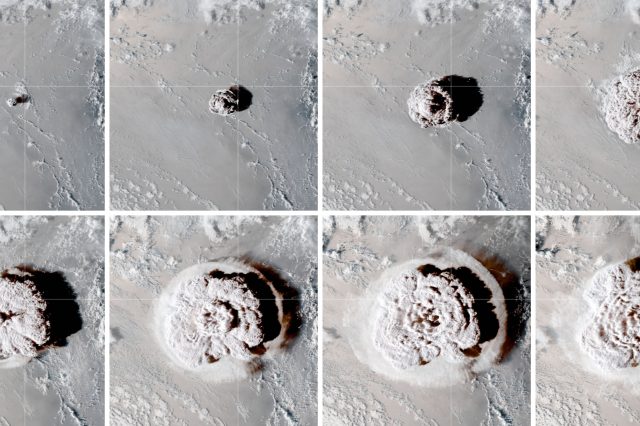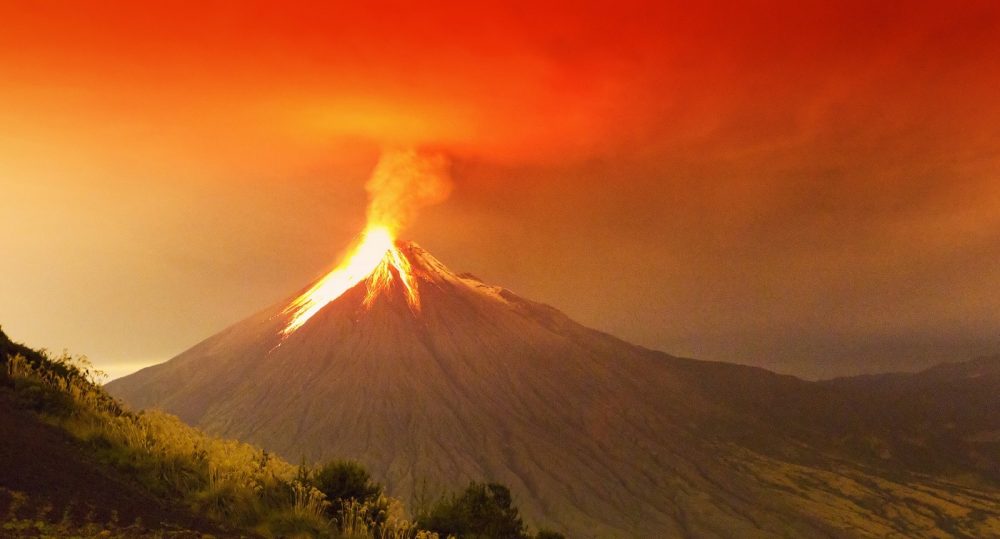The powerful eruption of the Hunga-Tonga-Hunga-Haapai volcano and the tsunami provoked by it led to large-scale destruction in the island Kingdom of Tonga in the Pacific Ocean.
The volcano belongs to the Tonga-Kermadec island arc – here the Pacific plate goes under the Indo-Australian one – and has never been particularly active.
From 1912 until January 2022, it erupted five times. None of the eruptions until the most recent one exceeded 2 on the Volcanic Activity Scale.
The January 15 eruption likely lies at or above 5 on this scale. This means, in particular, that it threw more than a cubic kilometer of ash to a height of more than 10 kilometers. With this said, here are five curious things that we learned after the powerful volcanic explosion.
The islands that surrounded the volcano disappeared almost entirely
As the scientists explained, in December 2014, after the eruption of the Tonga volcano, a new part of the land began to appear between the two uninhabited islands, forming a single volcanic island of Hunga-Tonga-Hunga-Hapai. According to them, the 2022 eruption was so powerful that the newly appeared part of the land disappeared along with two old islands.
During & after the eruption of an undersea volcano in the island nation of Tonga, @NASA & @NOAA satellites captured images of the plume and subsequent damage. These data help us understand the aftermath of the eruption on the ground and in the atmosphere.https://t.co/9J0ZbHcjZf pic.twitter.com/a7wzsdEzHP
— NASA Earth (@NASAEarth) January 19, 2022
Eruptions of this magnitude are rare
According to statistics, eruptions of this magnitude occur no more than once every 12 years. After accurate calculations of the amount of ash thrown out, the eruption in Tonga may turn out to be the most powerful on the planet in the last 30 years. Volcanologists are already comparing it to the catastrophic explosions of Krakatoa in Indonesia in 1883 and Pinatubo in the Philippines in 1991.
The energy released during the eruption was about 500 times stronger than the energy of the atomic bomb in Hiroshima.
The Hunga-Tonga-Hunga-Haapai eruption will not have long-term effects on the climate
Large eruptions in the past have cooled the planet’s climate by throwing ash and sulfate aerosols into the atmosphere. When Tambora Volcano erupted in Indonesia in 1815, the world’s average temperature dropped by 3 degrees Celsius. The Pinatubo eruption in 1991 also affected the global climate. The volcano spit out 17 megatons of sulfur dioxide, and over the next 15 months, temperatures averaged 0.6 degrees Celsius lower.
Hunga-Tonga-Hunga-Haapai, although it exploded powerfully, released only 0.4 megatons of SO 2 into the atmosphere. According to scientists, this is not enough to cause a noticeable climate shift. The cooling will be local – and will be a maximum of a few tenths of a degree.
People in Alaska heard the volcanic eruption
One of the most surprising reports was that the eruption was heard in Alaska, almost 10,000 kilometers away from the epicenter. In an Alaska public report, residents said they were awakened by a loud chime Saturday morning. Moving at the speed of sound – about 1225 km / h at sea level – the noises were heard about eight hours after the start of the eruption.
The blast from the #TongaEruption was strong enough to jiggle the atmosphere from the surface to the ionosphere. #HungaTongaHungaHaapai
Here are preliminary findings from researchers over the last 6 days.https://t.co/AX0XdCH5Yp pic.twitter.com/0tYNwqLpGI
— AGU's Eos (@AGU_Eos) January 21, 2022
Тhe Hunga-Tonga eruption caused fluctuations in the ionosphere
Scientists hadn’t recorded such clear acoustic-gravitational waves from a volcanic eruption to date. In most cases, AGWs are associated with tsunamis, earthquakes, and various types of artificial explosions.
The Hunga-Tonga-Hunga-Haapai volcano produced a shockwave that was able to penetrate the ionosphere, which is 80-90 kilometers above the surface of our planet. Even a week after the eruption, acoustic-gravitational waves were detected after orbiting our planet over and over again.
Join the discussion and participate in awesome giveaways in our mobile Telegram group. Join Curiosmos on Telegram Today. t.me/Curiosmos
Sources:
• Collins, J. (2022, February 8). The fallout from Tonga’s volcano goes deeper than the Ashes. The Interpreter.
• Latu-Sanft, J. (2022, February 7). The Tongan volcano is a reminder of island nations’ vulnerabilities. Scientific American.
• NASA. (n.d.). Tonga eruption sent ripples through Earth’s ionosphere.
• National Oceanic and Atmospheric Administration. (n.d.). Ripple effect: What the Tonga eruption could mean for tsunami research.





